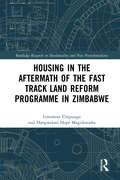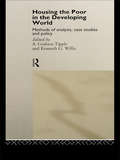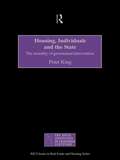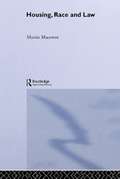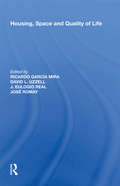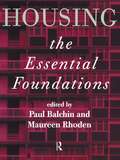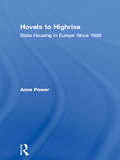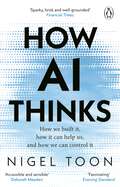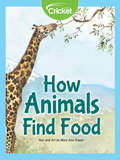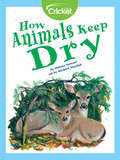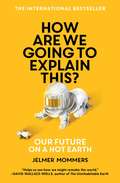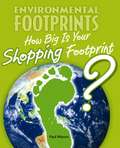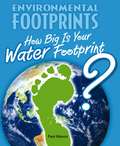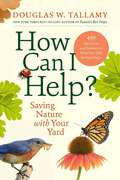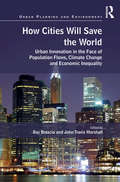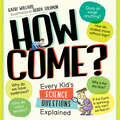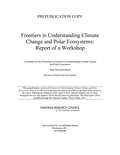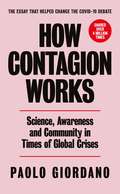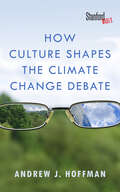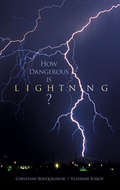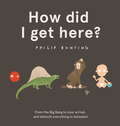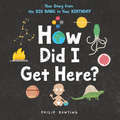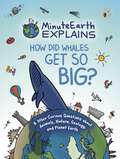- Table View
- List View
Housing in the Aftermath of the Fast Track Land Reform Programme in Zimbabwe (Routledge Research on Decoloniality and New Postcolonialisms)
by Hangwelani Hope Magidimisha Lovemore ChipunguThis book delves into the Fast Track Land Reform Programme (FTLRP) in Zimbabwe to provide insight into how it facilitated the delivery of housing for low-income urban households. It highlights the politics of land reforms and the power of community engagement in housing development in urban areas. Prior to the FTLRP, the Zimbabwean governments had never embraced popular modes of housing production as key factors in urban development. In the area of low-income housing, informal housing schemes have always been treated with apathy and indifference. This left the conventional mode of housing production to be the only legitimate means to house low-income households despite its shortcomings. However, the onset of the FTLRP in 2000 resulted in homeless urban households grasping the opportunity to invade farms for housing development. Through the lenses of Marxism and Neoliberalism, this book analyses housing schemes that emerged and the overall impact of the FTLRP on housing and land delivery in Harare. This analysis is based on empirical evidence obtained from key informants and household surveys conducted in Harare. The authors argue that the FTLRP provided a platform for innovativeness by households, supported by the unpronounced national urban vision and prowess of the political leadership. Hence the success of these housing schemes can be measured by acquisition of land which guarantees households access to the city. However, some of these housing schemes pose challenges – key among them being lack of infrastructure. The book concludes by presenting a new model for effective delivery of land and housing for the urban poor. This is envisaged as a useful policy tool for urban planners, housing experts, land economists, urban and regional geographers, as well as sociologists, political scientists and social workers engaged in public administration of land and housing.
Housing the Poor in the Developing World: Methods Of Analysis, Case Studies, And Policy
by Graham Tipple Kenneth G. TippleFirst Published in 2004. Routledge is an imprint of Taylor & Francis, an informa company.
Housing, Individuals and the State: The Morality of Government Intervention (Rics Issues In Real Estate And Housing Ser.)
by Peter KingCan the state solve housing problems or does it create them? This book explores the question by combining a detailed critique of contemporary housing policy with a philisophical analysis of the role of the state and individuals. Examining the state's role as controller and funder of housing, the author contends that the state is not capable of planning and controlling a sustainable housing policy.
Housing, Race and Law: The British Experience
by Martin MacEwenEquality of opportunity in housing is a key issue in social justice in Britain today. To the extent that it patterns an individual's educational, social and economic development, housing constitutes a crucial battleground in the fight against racial discrimination. Housing, Race and Law is the first publication to examine the law in relation to issues of housing and race in both the private and public sector. It places these issues in the broader context of the development of anti-discrimination legislation, outlines the current legislation and examines its impact in relation to owner occupation, public housing, housing association tenancies and private lets. Throughout, the book emphasizes the practical impact of the various legislative provisions, and discusses the responses of the principle institutions from government departments and relevant professions to the Commission for Racial Equality and the Community Relations Councils (or Racial Equality Councils). It argues a case for a new approach to appraisal, review and enforcement. By collating material from a wide variety of sources, the author provides an original assessment of the Race Relations Act of 1976 and its impact on housing which, in its provision of cogent material and arguments for reforms, is designed to be of value to practitioners, academics and those concerned with racial discrimination.
Housing, Space and Quality of Life (Ethnoscapes Ser.)
by David L. Uzzell J. Eulogio Real José Romay Ricardo García MiraHouses, and other spaces and environments in which people spend their time, have a crucial impact on quality of life. We are increasingly living in multi-cultural cities and communities, and this too significantly affects how we feel about spaces in which we live. This volume brings together psychologists, architects, designers and planners to discuss issues of housing, space, sustainability and multi-culturalism. In doing so, the book provides an insightful critical analysis of space, place and the quality of life. It also addresses the implications of intercultural tension on quality of life and on the way in which people use and interact in a multi-cultural space. With case studies from Spain, Turkey, Brazil, the UK, the USA and Israel, it discusses issues such as low-cost housing, security, environmental conservation and sustainability, alternative building techniques, cultural diversity and its impact on housing and urban design.
Housing: An Introduction
by Maureen Rhoden Paul BalchinHousing: The Essential Foundations provides a comprehensive introduction to housing studies. This topical text is essential reading for students embarking on degree and diploma courses in housing, surveying, town planning and other related subjects. Professionals within these fields will also find the book valuable as a source of up-to-date information and data. Uniquely multi-disciplinary and including a wealth of illustrations and examples, this book focuses on key topics which include: * equal opportunities and housing organisations * town planning and housing development * housing management, design and development * economics of housing * management and organisation * environmental health and housing * property, housing law, policy-making and politics * housing policy and finance prior to and post Thatcherism * future policy issues under the Labour government post 1997 Throughout the authors stress the importance of housing market activity that accords with good planning practice, legislation, democratic decision-making, economy and efficiency. In introducing the many diverse aspects of housing within a single volume, this book provides the essential foundations for the study of this multi-disciplinary subject. Paul Balchin, Gregory Bull, Pauline Forrester, David Isaac, R.Shean McConnell John O'Leary, Maureen Rhoden, Jane Weldon all at Univeristy of Greenwich, UK and Mark Pawlowski, University
Hovels to Highrise: State Housing in Europe Since 1850
by Anne PowerHovels to Highrise traces how governments in five European countries became involved in replacing industrial revolution urban slums with mass high-rise, high density concrete estates. As the book considers each country's housing history and traditions, and analyses the contrasting structures and systems, it finds convergence of problems in the growing tensions of their most disadvantaged communities. Anne Power underlines the continuing drift towards deeper polarization, a problem that the European Community will not be able to ignore with the interlocking but multi-lingual, multi-ethnic, urban societies of the future. The book's detailed coverage of the historical, political amd social changes relating to housing within the various countries make it an important text for students and practitioners concerned with housing, urban affairs, social policy and administration.
How AI Thinks: How we built it, how it can help us, and how we can control it
by Nigel ToonTHE #2 TIMES BESTSELLER'Artificial intelligence is going to have a massive impact on everyone’s lives... an accessible and sensible read that helps demystify AI' Deborah Meaden, entrepreneur and star of Dragon's Den'Nigel Toon is a visionary leader in the field of artificial intelligence... a must-read' Marc Tremblay, Distinguished Engineer, MicrosoftThose who understand how AI thinks are about to win big.We are used to thinking of computers as being a step up from calculators - very good at storing information, and maybe even at playing a logical game like chess. But up to now they haven't been able to think in ways that are intuitive, or respond to questions as a human might. All that has changed, dramatically, in the past few years.Our search engines are becoming answer engines. Artificial intelligence is already revolutionising sectors from education to healthcare to the creative arts. But how does an AI understand sentiment or context? How does it play and win games that have an almost infinite number of moves? And how can we work with AI to produce insights and innovations that are beyond human capacity, from writing code in an instant to unfolding the elaborate 3D puzzles of proteins?We stand at the brink of a historic change that will disrupt society and at the same time create enormous opportunities for those who understand how AI thinks. Nigel Toon shows how we train AI to train itself, so that it can paint images that have never existed before or converse in any language. In doing so he reveals the strange and fascinating ways that humans think, too, as we learn how to live in a world shared by machine intelligences of our own creation.
How Animal Babies Stay Safe (Let's-Read-and-Find-Out Science 1)
by Mary Ann FraserRead and find out about how animal parents keep their babies safe from predators in this colorfully illustrated nonfiction picture book.This is a clear and appealing science book for early elementary age kids, both at home and in the classroom. It looks at the many strategies animal babies use to survive in a dangerous world. Some babies hide in nests or dens, some ride on thier parents' back or in their pouches, some use camouflage, and some rely on their parents' sharp claws and teeth to fend off enemies. Whether showing "a mother monkey swinging through the jungle with her baby on her back or two baby raccoons peeking out of their tree-house home while their mother lures a bobcat away from her young," wrote Kirkus, this book captures the eternal appeal of baby animals.It's a Level 1 Let's-Read-and-Find-Out, which means the book explores introductory concepts perfect for children in the primary grades. The 100+ titles in this leading nonfiction series are:hands-on and visualacclaimed and trustedgreat for classroomsTop 10 reasons to love LRFOs:Entertain and educate at the same timeHave appealing, child-centered topicsDevelopmentally appropriate for emerging readersFocused; answering questions instead of using survey approachEmploy engaging picture book quality illustrationsUse simple charts and graphics to improve visual literacy skillsFeature hands-on activities to engage young scientistsMeet national science education standardsWritten/illustrated by award-winning authors/illustrators & vetted by an expert in the fieldOver 130 titles in print, meeting a wide range of kids' scientific interestsBooks in this series support the Common Core Learning Standards, Next Generation Science Standards, and the Science, Technology, Engineering, and Math (STEM) standards. Let's-Read-and-Find-Out is the winner of the American Association for the Advancement of Science/Subaru Science Books & Films Prize for Outstanding Science Series.
How Animals Find Food
by Mary Ann FraserAnimals get their energy from the food they eat. Animals depend on other living things for food. Some animals, called herbivores, eat plants; while others are carnivores that eat other animals. Scavengers, like vultures and hyenas, eat dead animals. Learn how different animals eat and how this determines how they look and where they live. Can you name other animals that are scavengers?
How Animals Keep Dry
by Melissa StewartMany animals take cover when it rains. They like to stay warm and dry too!
How Are We Going to Explain This?: Our Future on a Hot Earth
by Jelmer MommersThere&’s a new story in the making, one in which the consequences of our actions add up—and every contribution is meaningful.If climate change is the biggest threat humanity has ever faced, then why are we doing so little about it? And where do we go from here? Journalist Jelmer Mommers knows most people prefer not to talk or even think about climate change, and that is exactly why he wrote this book. Denial and despair are not the only possible responses to the current crisis. Drawing on the latest science, Mommers describes how we got here, what possible future awaits us, and how you can help make a difference. Five years in the making, How Are We Going to Explain This was an instant bestseller in the Netherlands. With this revised and updated translation, including responses to the COVID-19 pandemic, Mommers brings his unique blend of realism and hope to the wider world.
How Big Is Your Shopping Footprint? (Environmental Footprints)
by Paul MasonWhat sort of footprint are you leaving on the environment? Do you have a heavy footprint or a light footprint? Everything we do and everything we use has an impact on the environment. Heavy footprints harm the environment and use lots of natural resources. Light footprints harm the environment as little as possible and use fewer natural resources. Read the ENVIRONMENTAL FOOTPRINTS series to decide what type of footsteps you want to take in the future! In How Big Is Your Shopping Footprint? read about what makes up a shopping footprint and the effect this has on the environment. Discover ways to reduce your shopping footprint and live sustainably. Special Features Rethink! feature offers way to lighten your footprints Case studies give real-life examples of heavy-footprint and light-footprint actions. Rethink! Disposable plastic shopping bags create waste. Bringing reusable canvas bags to hold your purchases at the mall or grocery store lowers your shopping footprint.
How Big Is Your Water Footprint? (Environmental Footprints)
by Paul MasonWhat sort of footprint are you leaving on the environment? Do you have a heavy footprint or a light footprint? Everything we do and everything we use has an impact on the environment. Heavy footprints harm the environment and use lots of natural resources. Light footprints harm the environment as little as possible and use fewer natural resources. In How Big Is Your Water Footprint? read about what makes up a water footprint and the effect this has on the environment. Discover ways to reduce your water footprint and live sustainably. Special features: Rethink! feature offers ways to lighten your footprints. Case studies give real-life examples of heavy-footprint and light-footprint actions.
How Can I Help?: Saving Nature with Your Yard
by Douglas W. TallamyFrom a New York Times bestselling author, a wildlife ecology expert and environmental advocate provides readers with the next step in their ecological journey. In How Can I Help?, Tallamy tackles the questions commonly asked at his popular lectures and shares compelling and actionable answers that will help gardeners and homeowners take the next step in their ecological journey. Topics range from ecology, evolution, biodiversity and conservation to restoration, native plants, invasive species, pest control, and supporting wildlife at home. Tallamy keenly understands that most people want to take part in conservation efforts but often feel powerless to do so as individuals. But one person can make a difference, and How Can I Help? details how. Whether by reducing your lawn, planting a handful of native species, or allowing leaves to sit untouched, you will be inspired and empowered to join millions of other like-minded people to become the future of backyard conservation.
How Cities Will Save the World: Urban Innovation in the Face of Population Flows, Climate Change and Economic Inequality (Urban Planning and Environment)
by Ray Brescia John Travis MarshallCities are frequently viewed as passive participants to state and national efforts to solve the toughest urban problems. But the evidence suggests otherwise. Cities are actively devising innovative policy solutions and they have the potential to do even more. In this volume, the authors examine current threats to communities across the U.S. and the globe. They draw on first-hand experience with, and accounts of, the crises already precipitated by climate change, population shifts, and economic inequality. This volume is distinguished, however, by its central objective of traveling beyond a description of problems and a discussion of their serious implications. Each of the thirteen chapters frame specific recommendations and guidance on the range of core capacities and interventions that 21st Century cities would be prudent to consider in mapping their immediate and future responses to these critical problems. How Cities Will Save the World brings together authors with frontline experience in the fields of city redevelopment, urban infrastructure, healthcare, planning, immigration, historic preservation, and local government administration. They not only offer their ground level view of threats caused by climate change, population shifts, and economic inequality, but they provide solution-driven narratives identifying promising innovations to help cities tackle this century’s greatest adversities.
How Come?: Every Kid's Science Questions Explained
by Kathy WollardFact-filled, fun-filled, as interesting to parents as it is to kids, the How Come? series is the trusted source for lively, clear answers to kids’ science queries. Now the best questions and answers from all three books—How Come?; How Come? Planet Earth; and How Come? In the Neighborhood—have been revised, updated, freshly illustrated in full color, supplemented with twenty completely new questions, and combined into one bigger, better volume. How Come? explains, in fascinating detail, more than 200 mysteries and phenomena in the world around us. These are the questions that pique kids’ curiosity—and stump parents.When it rains, does running (rather than walking) to the nearest shelter really keep you any drier? How can a stone skip across a pond (instead of sink)? If the Earth is spinning, why can’t we feel it? Why don’t we fly off? Why do elephants have trunks? And the all-time classic, Why is the sky blue? (Sunlight has a hidden rainbow of colors, and air molecules scatter blues the most—sending bright blue light down to Earth.) The text is clearly written, engaging, and accessible. It’s for every kid who wants to know—and every grown-up who simply doesn’t know.
How Communities Can Use Risk Assessment Results: A Summary of the June 3, 2010 Workshop of the Disasters Roundtable
by National Research Council of the National AcademiesThe polar regions are experiencing rapid changes in climate. These changes are causing observable ecological impacts of various types and degrees of severity at all ecosystem levels, including society. Even larger changes and more significant impacts are anticipated. As species respond to changing environments over time, their interactions with the physical world and other organisms can also change. This chain of interactions can trigger cascades of impacts throughout entire ecosystems. Evaluating the interrelated physical, chemical, biological, and societal components of polar ecosystems is essential to understanding their vulnerability and resilience to climate forcing. The Polar Research Board (PRB) organized a workshop to address these issues. Experts gathered from a variety of disciplines with knowledge of both the Arctic and Antarctic regions. Participants were challenged to consider what is currently known about climate change and polar ecosystems and to identify the next big questions in the field. A set of interdisciplinary "frontier questions" emerged from the workshop discussions as important topics to be addressed in the coming decades. To begin to address these questions, workshop participants discussed the need for holistic, interdisciplinary systems approach to understanding polar ecosystem responses to climate change. As an outcome of the workshop, participants brainstormed methods and technologies that are crucial to advance the understanding of polar ecosystems and to promote the next generation of polar research. These include new and emerging technologies, sustained long-term observations, data synthesis and management, and data dissemination and outreach.
How Contagion Works: Science, Awareness and Community in Times of Global Crises - The short essay that helped change the Covid-19 debate
by Paolo Giordano'Lucid, calm, informed, directly helpful in trying to think about where we are now... The literature of the time after begins here' Evening Standard'Taking a breather from bewildering statistics and terrible tales of contagion to read Giordano's book was a jolt of brevity and simplicity... It takes concepts that have been dancing away in our minds, just out of reach, and lines them up neatly' The Times'Potent and original' Sunday Times'In one short hour, in the midst of this difficult moment, Giordano reinforced my sense of hope in humanity, in the one and the many' Philippe Sands, author of East West Street and The Rat LineThe Covid-19 pandemic is the most significant health emergency of our time.Writing from Italy in lockdown, physicist and novelist Paolo Giordano explains how disease spreads in our interconnected world: why it mattershow it impacts ushow we must reactExpanding his focus to include other forms of contagion - from the environmental crisis to fake news and xenophobia - Giordano shows us not just how the coronavirus crisis got so bad so quickly, but also how we can work together to create change.Paolo Giordano is a physicist and the author of four bestselling novels. His article 'The Mathematics of Contagion' - published in Italy at the beginning of the coronavirus emergency - was shared more than 4 million times and helped shift public opinion in the early stages of the epidemic.
How Culture Shapes the Climate Change Debate
by Andrew J. HoffmanThough the scientific community largely agrees that climate change is underway, debates about this issue remain fiercely polarized. These conversations have become a rhetorical contest, one where opposing sides try to achieve victory through playing on fear, distrust, and intolerance. At its heart, this split no longer concerns carbon dioxide, greenhouse gases, or climate modeling; rather, it is the product of contrasting, deeply entrenched worldviews. This brief examines what causes people to reject or accept the scientific consensus on climate change. Synthesizing evidence from sociology, psychology, and political science, Andrew J. Hoffman lays bare the opposing cultural lenses through which science is interpreted. He then extracts lessons from major cultural shifts in the past to engender a better understanding of the problem and motivate the public to take action. How Culture Shapes the Climate Change Debate makes a powerful case for a more scientifically literate public, a more socially engaged scientific community, and a more thoughtful mode of public discourse.
How Dangerous Is Lightning?
by Vladimir Rakov Christian BouquegneauLightning strikes somewhere on the surface of the earth about 100 times every second, and current observations indicate a significant increase in activity in the coming years. This illustrated survey explores the history of lightning, from ancient to modern times. Mythology and observations of lightning damage constituted the extent of lightning history until the Enlightenment period, when Benjamin Franklin, Thomas-François Dalibard, and others began applying a scientific approach. Detailed studies began at the dawn of the twentieth century, with the advent of modern instrumentation. This volume presents up-to-date views of thunderstorm clouds, lightning phenomenology and parameters, spatial distribution of lightning activity, and the global electric circuit. It explores the physical effects of lightning as well as secondary effects, lightning protection, and new frontiers in the understanding of lightning. An information-based study, this book is appropriate for classroom use as well as for popular science readers of all ages.
How Deep Is the Ocean? (Let's-Read-and-Find-Out Science 2)
by Kathleen Weidner ZoehfeldRead and find out about the deepest part of the ocean in this colorfully illustrated nonfiction picture book.The ocean covers almost three-quarters of the Earth, but how deep does it go? Put on your scuba gear and explore the ocean, from its shallowest waters to its deepest, most mysterious parts. As you dive deeper, you’ll discover glowing animals, strange creatures that don’t need sunlight to survive, and even the largest hunter in the world.With beautiful illustrations and engaging text, How Deep Is the Ocean? will guide young readers into the deepest parts of the ocean. Featuring a find-out-more section with a water-pressure experiment, a lesson in making a sounding line to learn how scientists measure the depth of the ocean, a glossary of new terms, and web research prompts, this book will begin children’s explorations of the deep sea. Both the text and the artwork were vetted for accuracy by Dr. David Gruber, real-life deep sea explorer and professor of biology and environmental science at Baruch College.This is a clear and appealing science book for early elementary age kids, both at home and in the classroom. It's a Level 2 Let's-Read-and-Find-Out, which means the book explores more challenging concepts for children in the primary grades. The 100+ titles in this leading nonfiction series are:hands-on and visualacclaimed and trustedgreat for classroomsTop 10 reasons to love LRFOs:Entertain and educate at the same timeHave appealing, child-centered topicsDevelopmentally appropriate for emerging readersFocused; answering questions instead of using survey approachEmploy engaging picture book quality illustrationsUse simple charts and graphics to improve visual literacy skillsFeature hands-on activities to engage young scientistsMeet national science education standardsWritten/illustrated by award-winning authors/illustrators & vetted by an expert in the fieldOver 130 titles in print, meeting a wide range of kids' scientific interestsBooks in this series support the Common Core Learning Standards, Next Generation Science Standards, and the Science, Technology, Engineering, and Math (STEM) standards. Let's-Read-and-Find-Out is the winner of the American Association for the Advancement of Science/Subaru Science Books & Films Prize for Outstanding Science Series.
How Did I Get Here?
by Philip BuntingThis is the unathorised biography of you. Charting your incredible journey from Big Bang to birth (in about the time it takes to eat your breakfast), Philip Bunting's hilarious and one of a kind history of evolution was created to raise more questions than it answers. Perfect for fans of Jon Klassen and Chris Haughton.
How Did I Get Here?: Your Story from the Big Bang to Your Birthday
by Philip BuntingFrom the Big Bang to your birthday, and (almost) everything in between, this funny and informative book tells your story.You are one of the newest members of a family tree that goes way, way, way back to the very first life on Earth. A lot of incredible things had to happen between the beginning of the universe and today in order to make you. The fact that you (and everyone you know) are here is nothing short of mind-boggling! Read this book to discover how it happened, and prepare to be amazed by the awesomeness of you.This clever, funny, and scientific timeline of the journey of human existence is designed to get young readers asking questions, finding answers, and marveling at the many wonders of our world, from the Big Bang, to evolution, to a brand-new baby, and more.
How Did Whales Get So Big?: & Other Curious Questions about Animals, Nature, Geology, and Planet Earth (MinuteEarth Explains)
by MinuteEarthSTEM for Kids ― Fun for Kids (Ages 8-10)#1 New Release in Children's Books: Environment & Ecology, Atlases, Anatomy, and Earthquake & VolcanoIn their debut illustrated science book for kids, the team behind the popular YouTube channel MinuteEarth answers all of your child’s wackiest questions about animals, nature, and science alongside engaging images of the natural world.From the scientists, writers, and illustrators at MinuteEarth. Have you ever wondered where Earth’s water came from? Or why leaves change color in the fall? Entertain and educate your kids with fun facts about animals, nature and the wonders of the earth.Amazing STEM for kids, explained simply. With over 300 million views, MinuteEarth simplifies such serious subjects as geology, ecology and biology making them fun for kids. Featuring their signature puns and fun illustrations, this first book in the MinuteEarth Explains series explores topics ranging from weird animal facts to extreme weather, making science for kids enjoyable and unforgettable.Curious questions about our awesome planet. Whether your child is obsessed with the wonder of nature, can’t learn enough interesting facts about animals, or is fascinated by volcanoes, MinuteEarth Explains captures their imagination and fosters an interest in animals, the Earth, and ocean life! By combining humor with rigorous research, this book provides fun facts about animals, nature, science and more in an equally engaging and informative way for kids.MinuteEarth Explains captivates kids with answers to:Why do some animals get gigantic?Why do rivers curve?Can plants talk?How much food is there on earth?And more!If you’re looking for nature books for kids (8-10) or earth science books for kids―or if your child loves books such as The Big Book of Birds, Why?: 1,111 Answers to Everything, or The Wondrous Workings of Planet Earth―then your whole family will love this debut book by MinuteEarth!
